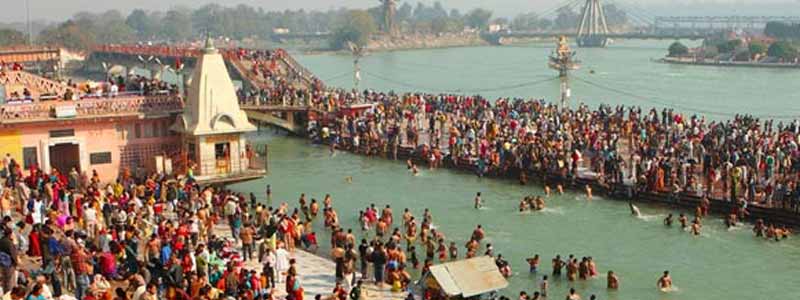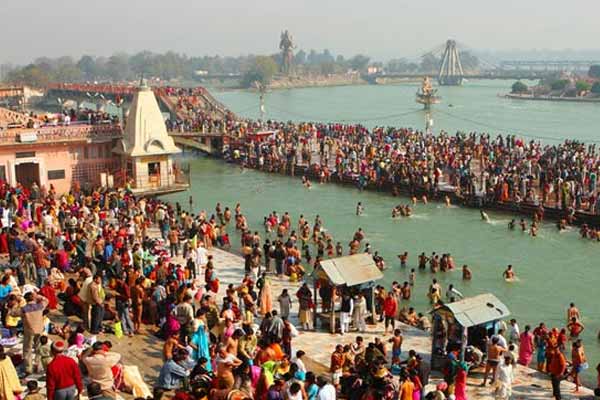Gangasagar Mela Festival is a significant religious festival celebrated annually in India, particularly in the state of West Bengal. It holds great spiritual and cultural importance for Hindus and draws pilgrims and tourists from various parts of the country.
The festival is centered around the holy confluence of the Ganges River (known as the Ganga) and the Bay of Bengal at Sagar Island. This auspicious junction is believed to possess immense spiritual energy, and taking a dip in these sacred waters is considered highly purifying in Hindu tradition.
The Gangasagar Mela typically occurs in the month of January during the auspicious occasion of Makar Sankranti. The pilgrimage is a testament to the devotion of thousands who travel great distances to be part of this religious gathering. Pilgrims undergo rigorous journeys, often walking for days, to reach the island.
Upon arrival, devotees engage in various rituals and prayers, seeking blessings and absolution. They offer coconuts, sweets, and other symbolic items to the river as an expression of their faith. Sadhus, holy men, and spiritual leaders congregate to impart teachings and blessings to the gathered crowd.
Apart from the religious fervor, the Gangasagar Mela also showcases a vibrant cultural panorama. Temporary settlements, known as ‘camps,’ spring up to accommodate the influx of pilgrims. These camps are bustling with activity, with makeshift markets, cultural performances, and communal kitchens serving meals to the attendees kolkata tourist attractions.
The festival is a testament to the unity and diversity of India, as people from various walks of life come together to celebrate their shared faith. It also serves as a reminder of the ecological significance of the Ganges delta and the need for its preservation.
In recent years, efforts have been made to improve the infrastructure and facilities for the pilgrims, ensuring their safety and comfort during this massive gathering. The Gangasagar Mela stands as a testament to the enduring spiritual heritage of India and continues to be a revered event in the country’s cultural tapestry.

History of Gangasagar Mela
The history of the Gangasagar Mela is deeply intertwined with Hindu mythology and has roots dating back thousands of years. According to ancient scriptures, the significance of Gangasagar is linked to a legend involving King Bhagirath, a prominent figure in Hindu mythology.
Legend has it that King Bhagirath, the forefather of the legendary hero Rama, sought to bring the divine river Ganga (Ganges) down to Earth in order to cleanse the souls of his ancestors who had been cursed by the sage Kapila. He undertook rigorous penance for thousands of years to appease Lord Brahma, the creator of the universe, who eventually granted his request kolkata tour packages.
The descent of the Ganges was not without challenges. It was believed that the force of the river’s fall from the heavens could obliterate the Earth. To mitigate this, Lord Shiva, the god of destruction, agreed to cushion Ganga’s fall on his matted locks. This divine event is known as Ganga Avataran, and it is celebrated annually during the Gangasagar Mela.
As per the legend, the confluence of the Ganges, the Bay of Bengal, and the sacred Kapil Muni Teerth (where Sage Kapila meditated) at Sagar Island is considered an especially auspicious location. It is believed that taking a holy dip at this juncture on the day of Makar Sankranti absolves one of sins and guarantees spiritual liberation Gangasagar Mela Festival.
Over the centuries, the Gangasagar Mela evolved from being a small-scale religious gathering to a grandiose event drawing millions of devotees. The festival not only holds immense religious significance but also serves as a testament to the enduring cultural and spiritual heritage of India.
In recent times, the government of West Bengal and various organizations have taken steps to modernize and manage the logistics of the mela, ensuring the safety and well-being of the pilgrims. The festival continues to be a vibrant display of faith, unity, and cultural diversity, attracting people from all corners of India and beyond. It stands as a living testament to the enduring power of ancient traditions in the modern world.
Best Time to Visit Ganga Sagar Mela
The best time to visit the Gangasagar Mela is during the Makar Sankranti festival, which typically falls in the month of January. Makar Sankranti marks the transition of the sun into the zodiac sign of Capricorn and is considered an auspicious time for taking a holy dip in the Ganges River (Ganga) at the confluence with the Bay of Bengal (Sagar).
Here are a few reasons why visiting during Makar Sankranti is ideal:
Spiritual Significance: Makar Sankranti is a highly auspicious day in the Hindu calendar. Taking a dip in the holy waters at Gangasagar during this time is believed to cleanse one of sins and ensure spiritual purification and salvation (moksha).
Vibrant Atmosphere: The Gangasagar Mela during Makar Sankranti is a vibrant and colorful event. The temporary tent city that emerges along the coastline is bustling with pilgrims, sadhus (ascetics), and tourists. The atmosphere is filled with devotional chants, rituals, and cultural performances.
Cultural Experience: This is not just a religious pilgrimage but also a cultural extravaganza. It provides a unique opportunity to witness diverse traditions, rituals, and customs of India, as people from various regions come together to celebrate.
Mild Weather: January is typically a cooler and more comfortable time to visit this region of West Bengal compared to the scorching heat of summer or the monsoon season, making the pilgrimage more bearable for the devotees.
Accessibility: The West Bengal government and local authorities make special arrangements for transportation, medical facilities, and security during the Gangasagar Mela Festival, especially during Makar Sankranti. This ensures a smoother and safer experience for visitors.
Keep in mind that since this festival attracts millions of pilgrims and tourists, it’s advisable to plan your trip well in advance. Accommodations can fill up quickly, and transportation can be crowded, so making reservations and preparations early is a good idea if you plan to visit during Makar Sankranti.
How to reach?
By air-Kolkata airport, i.e., Netaji Subhash Chandra Bose Airport.
By train-Sealdah South lines from Kolkata to Namkhana. Ferry cross available at Bakkhali to Sagar Island.
By road-Esplanade, Kolkata to Harwood point.
After the ferry crossing, catch the Kachuberia bus to reach the pilgrim destination.
